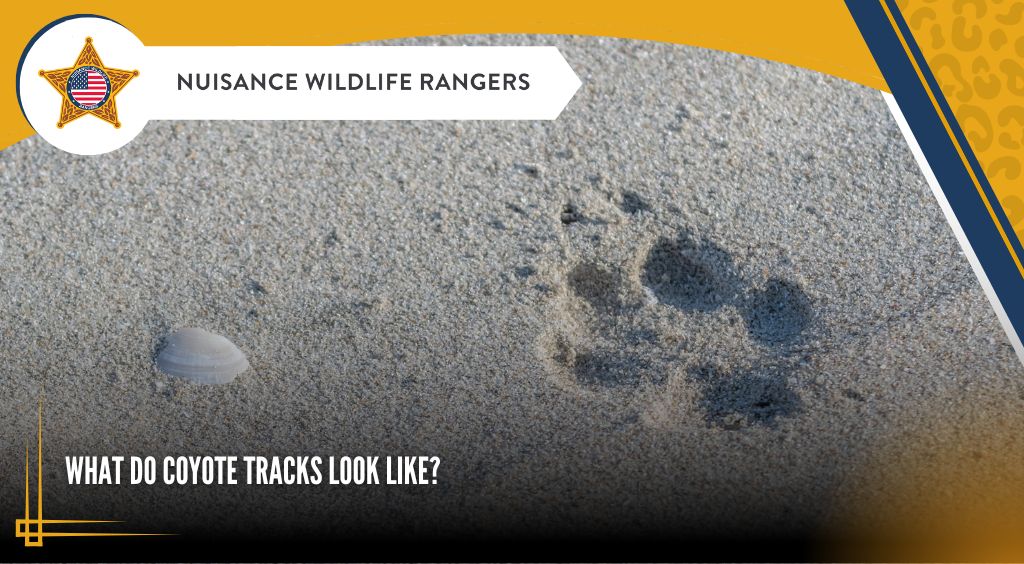
Coyotes inhabit deserts, marshes, mountains, and urban areas throughout the United States. In fact, coyotes live in 49 states.
They are usually looking for food. If you find one stalking around your backyard, it’s likely because it smells like a food source.
While coyotes look cool, you should never get too close to one. They might feel threatened, causing them to become defensive and attack. Coyotes are extremely fast, so running from them could also be dangerous.
If you notice that your trash cans have been overturned, you might wonder if coyotes are involved. Identifying their tracks can help you determine whether coyotes are visiting your yard. You should always contact a professional wildlife removal company to relocate coyotes.
Identifying Coyote Tracks
Coyote tracks can be challenging to spot because they are similar to other canines. However, a few defining characteristics distinguish them from different types of tracks.
Coyotes in suburban areas might be hunting domesticated animals like cats or dogs. Keep your eyes out for packs of coyotes when you take your dog on a walk.
To identify coyote tracks, take a look at the following characteristics:
Shape
Coyote tracks are oval-shaped. Their paws resemble cats or dogs, with four toes on each pad.
However, coyote tracks have more defined heel impressions than dogs do. Additionally, dogs have less negative space between their toes and heel pads than coyotes.
Size
Coyote prints have fewer variations in size than other animals. Typically, a coyote’s front paws are two and a half inches long by two inches wide. Their back paw prints are a little smaller, at two and a quarter inches long and one and three-quarters in width.
Claw Marks
While cats can retract their claws, coyotes cannot, so their tracks will also have claw prints.
When compared to dogs, the claw marks look different too. Dog tracks have four instinct claw marks on the middle toes. On the other hand, coyotes only have two.
Coyotes will have a more prominent mark on the ground from the tip of their nails than dogs. Obviously, you will not be able to identify a coyote track by its nail prints if it’s left on concrete or a hard surface.
What Animals Have Similar Tracks to Coyotes?
There are a few animals that have similar tracks to coyotes. Knowing what they look like can help you determine what tracks you are finding around your home.
Foxes
Fox tracks are about two to two and a half inches long. Different from coyotes, foxes have smaller and narrower toes.
Wolves
Wolf tracks look similar to coyotes, but they have much bigger paws. Wolf prints are about five inches long and 4 inches wide. Additionally, the stride between each print will be longer than coyotes, as wolves run faster.
Dogs
Domestic dog prints can look very similar to coyote prints, but coyote toe prints are narrower and oval-shaped.
What Should You Do if You Spot Coyote Tracks?
If you notice coyote tracks around your home, you might begin to feel nervous. After all, coyotes can attack pets like dogs or cats. Call a professional wildlife removal company if you think coyotes are around your property.
In addition, you should move any potential food sources. If you leave your dog’s food outside, it will attract coyotes. You should seal off pet doors if a coyote wants to enter your home.
Once the animal removal company arrives, they can remove coyotes from the area. Professionals conduct this ethically, ensuring they do not harm the coyotes.
Wildlife removal companies like Nuisance Wildlife Rangers trap the coyotes and relocate them into a safe area. They can also help you devise preventative measures to ensure the coyotes do not return.
What Should You Do if You See a Coyote?
If you come face to face with a coyote, do not panic. Running from coyotes might cause them to believe you are prey. Instead, raise your arms and shout in a deep voice.
Doing this will make the coyote more likely to see you as a bigger predator, preventing them from attacking. If you walk your dog or have small children around, take them to a safer location.
If the loud noises do not work, you can throw small stones, sticks, or anything else you can find. Doing so should scare the coyote away. Remember that the goal is to scare them instead of harming them.
Once you are no longer in immediate danger, contact a wildlife removal service to begin the relocation process.
Get Connected to a Professional Wildlife Removal Service
At Nuisance Wildlife Rangers, we can help you with any wild animal issues. If coyotes are roaming your yard, we can remove them safely and ethically. Instead of harming animals, we use a safe trapping and relocation method.
The professionals at Nuisance Wildlife Rangers have years of experience in wildlife removal services. We can help you with any wildlife issue, whether you have rats in your attic or coyotes in your backyard.
Contact us today to learn more about our coyote removal services.
